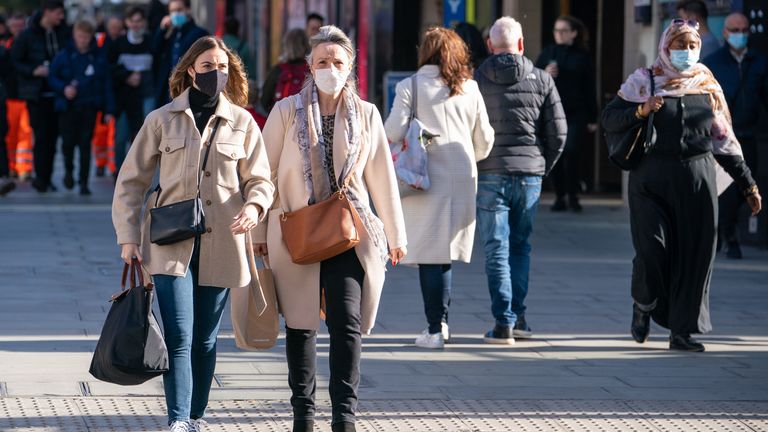Britain’s economic growth slowed in the third quarter as weak consumer spending and supply chain issues put the brakes on the recovery, according to official figures.
The pound fell below $1.34 to hit its lowest level against the US dollar since last December after gross domestic product (GDP) expanded by a slightly weaker than expected 1.3%, down from 5.5% in the second quarter.
Supply issues were among the factors with car sales held back by chip shortages and builders struggling to find construction materials – while tough trading for retailers also took its toll.
4:34 ‘We’re doing better than other countries except US’A monthly breakdown of the data from the Office for National Statistics (ONS) suggested that in September, GDP was just 0.6% shy of its level in February 2020, before the pandemic struck.
But Britain lagged behind global rivals, with the figures showing the economy was 2.1% smaller than at the end of 2019 – a bigger shortfall than that of G7 rivals Germany, Italy and France, while the US is already back above pre-pandemic levels.
AdvertisementFor the quarter as a whole, growth in the UK’s dominant services sector – representing four-fifths of output – was held back by weak consumer spending, with successive months of decline in retail sales.
Easing restrictions and the reopening of the economy helped sub-sectors such as hotels and restaurants – up 30% – and arts and entertainment – which grew by 19.6%.
More from BusinessOverall household spending grew by 2% but was still 4.4% lower than at the end of 2019.
Samuel Tombs, chief UK economist at Pantheon Macroeconomics, said consumers “still aren’t willing to spend a normal share of their incomes” – attributing this to public caution amid high COVID case numbers and the end of much of the government’s pandemic-era support over the period.
Analysis by Ed Conway, Economics & data editorThe economy is recovering, but the pace of that recovery is diminishing – that’s the big picture from today’s gross domestic product statistics.
However, the UK is getting ever closer now to regaining the income lost during the crisis.
Quite where we are on that front depends somewhat on which measure you’re looking at.
Once upon a time we only got updates on the state of the economy and gross domestic product – the most comprehensive measure of activity – every quarter, but these days we get them every month.
On the quarterly measure, we are still a fair way off getting back to where we were before the pandemic struck, but on the monthly measure we are now very close.
However, getting back to the pre-crisis level is only half the battle.
Meanwhile the manufacturing sector – where car factories have been hit by a global shortage of semiconductor chips – and construction – which saw higher input prices and delays to the availability of some products – both contracted over the period.
There was also a negative impact from net trade – which has been hampered by Brexit issues this year – as goods exports fell by 5.8%.
Chancellor Rishi Sunak said: “The economy continues to recover from COVID and thanks to schemes like furlough, the unemployment rate has fallen for eight months in a row and we’re forecast to have the fastest growth in the G7 this year.
“As the world reopens we know that there are still challenges to overcome.”
Image: Motorists queue for fuel at an ESSO petrol station in Ashford, Kent. Picture date: Friday October 1, 2021.But Bridget Phillipson, Labour’s shadow chief secretary to the Treasury, said: “This morning’s GDP figures confirm that the economic recovery is slowing and risks grinding to a halt.
“We need urgent action to keep the economy moving and support households as we head into the winter, as prices rise and as the cost of living crisis continues to escalate.”
The slowdown in third quarter growth comes after the Bank of England last week surprised markets when it refrained from hiking interest rates despite rising inflation – as it waits to see how the economy copes with the end of the furlough scheme and other challenges such as the supply chain crisis.
